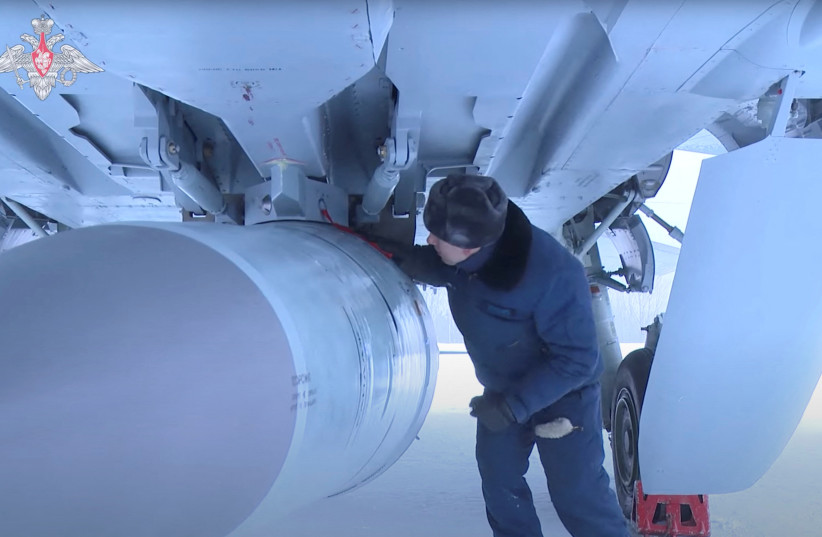The Russian "Kinzhal" hypersonic missile was used for the first time in Ukraine in a strike on a military base in Ukraine, according to Russian state media outlet RIA.
The hypersonic aeroballistic Kh-47M2 "Kinzhal" or "Dagger" was reportedly used to strike a military fuel depot near the southern Ukrainian city of Mykolaiv.
In a separate strike, the Russian Defense Ministry also claimed that it had killed more than 100 Ukrainian soldiers and foreign mercenaries in a strike near Zhytomyr, which is west of Kyiv. RIA reported that it was a major training base for foreign volunteers.
The Ukrainian military noted on Sunday the ongoing "threat of long-range high-precision missile strikes by the enemy, including the "Kinzhal" hypersonic missile system."
<br>Hypersonic "Kinzhal" system

The Kinzhal is a hypersonic missile launched from a warplane and has an effective range of 2,000 km or 3,000 km depending on if the weapon is deployed from a fighter jet or bomber, according to the Russian state media outlet TASS. The missile can strike its target within several minutes of launch.
"The Kinzhal system substantially boosts the capabilities of the Russian Aerospace Force to respond to any possible act of aggression against our country and along with other strategic weapon systems will help deter possible adversaries from rushing headlong into action," Aerospace Force Commander Sergei Surovikin said in MArch 2018, TASS reported at the time.
"The fast-speed fixed-wing carrier allows delivering a missile with unique performance characteristics to the area of its discharge within minutes. The main propulsion unit mounted on the aero-ballistic missile accelerates a warhead to hypersonic speed within seconds. The missile’s maneuvering at speeds exceeding the speed of sound by several times allows it to reliably breach all air defense and anti-ballistic missile defense systems that exist or are being developed."
New Zircon hypersonic missile production delayed
The production of the air-to-ground version of the Russian Zicron hypersonic cruise missile has been delayed due to a backlog, Russian Defense company NPO Mashinostroeniya's Deputy General Director Anatoly Svintsov announced on Sunday, according to TASS.
"For the air-launched version, we also have a big backlog. When the time comes, we will definitely continue this work, but for now, the country already has a hypersonic aviation missile — This is the Kinzhal missile," Svintsov reportedly said.
Svintsov said that the Zircon missile was being developed with two versions, sea-to-ground and air-to-ground. However, "The customer made a decision at the first stage to intensify work on the creation of a marine version of the rocket," he explained, TASS reported.
In 2020 Russian media outlet Sputnik claimed that the Zircon would be able to reach speeds of Mach 10.
<br>What are hypersonic missiles?
Hypersonic missiles are projectiles that travel faster than Mach-5.
According to NPR, there are different variations of hypersonic weapons, including guided ballistic missiles, launched by hypersonic glide vehicles, and hypersonic cruise missiles.
These weapons challenge modern missile defense systems with their speed and maneuverability — Even in the upper atmosphere — US Defense Department officials have warned.
<br>Who has hypersonic weapons?
During January missile tests, North Korea tested hypersonic missiles, and in October it was alleged by the US military that China had successfully tested a hypersonic glide vehicle. In the early days of the Russia-Ukraine War, Russian President Vladimir Putin ordered his military command to put Russia's nuclear and hypersonic missile forces on high alert.
"Hypersonic technology is something that we have been concerned about, the potential military applications of it and we have held back from pursuing military applications for this technology," US disarmament ambassador Robert Wood said in October. "We have seen China and Russia pursuing very actively the use, the militarisation of this technology so we are just having to respond in kind...We just don't know how we can defend against that technology, neither does China, neither does Russia."
The US Defense Department said in 2021 that it was still developing hypersonic weapons. On January 12, the US Defense Department's Program Executive Office Ships announced the next generation of guided-missile destroyers, designed to support the installation of high-power lasers and planned hypersonic missiles.
Reuters and Jerusalem Post Staff contributed to this report.
